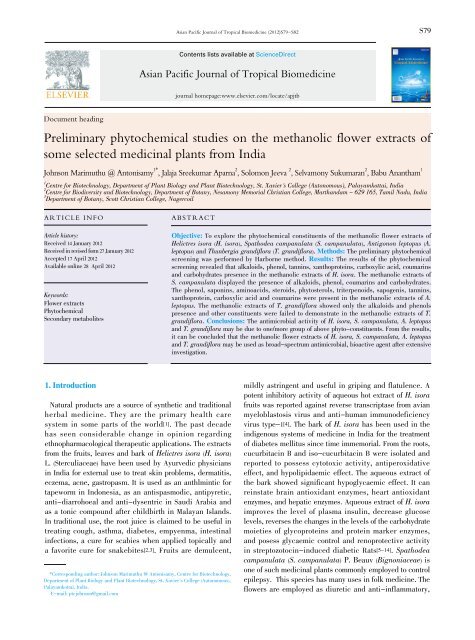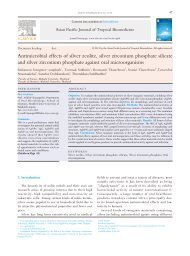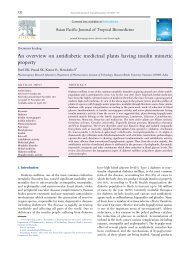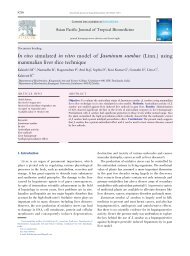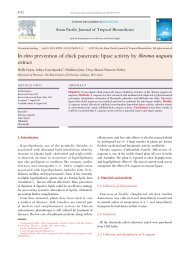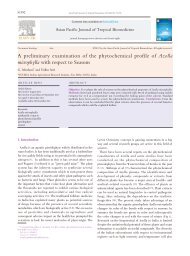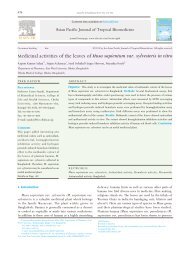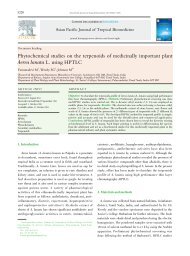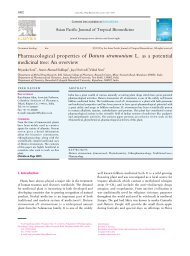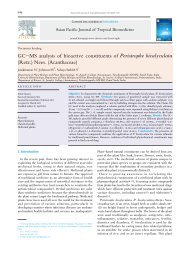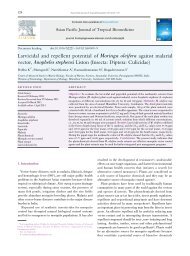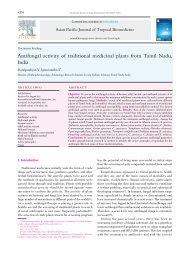Preliminary phytochemical studies on the methanolic ... - Apjtb.com
Preliminary phytochemical studies on the methanolic ... - Apjtb.com
Preliminary phytochemical studies on the methanolic ... - Apjtb.com
Create successful ePaper yourself
Turn your PDF publications into a flip-book with our unique Google optimized e-Paper software.
Document heading<br />
<str<strong>on</strong>g>Preliminary</str<strong>on</strong>g> <str<strong>on</strong>g>phytochemical</str<strong>on</strong>g> <str<strong>on</strong>g>studies</str<strong>on</strong>g> <strong>on</strong> <strong>the</strong> <strong>methanolic</strong> flower extracts of<br />
some selected medicinal plants from India<br />
Johns<strong>on</strong> Marimuthu @ Ant<strong>on</strong>isamy 1*<br />
, Jalaja Sreekumar Aparna 2 , Solom<strong>on</strong> Jeeva 2 , Selvam<strong>on</strong>y Sukumaran 2 , Babu Anantham 1<br />
1 Centre for Biotechnology, Department of Plant Biology and Plant Biotechnology, St. Xavier's College (Aut<strong>on</strong>omous), Palayamkottai, India<br />
2 Centre for Biodiversity and Biotechnology, Department of Botany, Nesam<strong>on</strong>y Memorial Christian College, Marthandam - 629 165, Tamil Nadu, India<br />
3 Department of Botany, Scott Christian College, Nagercoil<br />
ARTICLE INFO ABSTRACT<br />
Article history:<br />
Received 14 January 2012<br />
Received in revised form 27 January 2012<br />
Accepted 17 April 2012<br />
Available <strong>on</strong>line 28 April 2012<br />
Keywords:<br />
Flower extracts<br />
Phytochemical<br />
Sec<strong>on</strong>dary metabolites<br />
1. Introducti<strong>on</strong><br />
Natural products are a source of syn<strong>the</strong>tic and traditi<strong>on</strong>al<br />
herbal medicine. They are <strong>the</strong> primary health care<br />
system in some parts of <strong>the</strong> world[1]. The past decade<br />
has seen c<strong>on</strong>siderable change in opini<strong>on</strong> regarding<br />
ethnopharmacological <strong>the</strong>rapeutic applicati<strong>on</strong>s. The extracts<br />
from <strong>the</strong> fruits, leaves and bark of Helictres isora (H. isora)<br />
L. (Sterculiaceae) have been used by Ayurvedic physicians<br />
in India for external use to treat skin problems, dermatitis,<br />
eczema, acne, gastropasm. It is used as an anthlmintic for<br />
tapeworm in Ind<strong>on</strong>esia, as an antispasmodic, antipyretic,<br />
anti-diarrohoeal and anti-dysentric in Saudi Arabia and<br />
as a t<strong>on</strong>ic <strong>com</strong>pound after childbirth in Malayan Islands.<br />
In traditi<strong>on</strong>al use, <strong>the</strong> root juice is claimed to be useful in<br />
treating cough, asthma, diabetes, empyenma, intestinal<br />
infecti<strong>on</strong>s, a cure for scabies when applied topically and<br />
a favorite cure for snakebites[2,3]. Fruits are demulcent,<br />
*Corresp<strong>on</strong>ding author: Johns<strong>on</strong> Marimuthu @ Ant<strong>on</strong>isamy, Centre for Biotechnology,<br />
Department of Plant Biology and Plant Biotechnology, St. Xavier's College (Aut<strong>on</strong>omous),<br />
Palayamkottai, India.<br />
E-mail: ptcjohns<strong>on</strong>@gmail.<strong>com</strong><br />
Asian Pacific Journal of Tropical Biomedicine (2012)S79-S82<br />
C<strong>on</strong>tents lists available at ScienceDirect<br />
Asian Pacific Journal of Tropical Biomedicine<br />
journal homepage:www.elsevier.<strong>com</strong>/locate/apjtb<br />
S79<br />
Objective: To explore <strong>the</strong> <str<strong>on</strong>g>phytochemical</str<strong>on</strong>g> c<strong>on</strong>stituents of <strong>the</strong> <strong>methanolic</strong> flower extracts of<br />
Helictres isora (H. isora), Spathodea campanulata (S. campanulata), Antig<strong>on</strong><strong>on</strong> leptopus (A.<br />
leptopus) and Thunbergia grandiflora (T. grandiflora). Methods: The preliminary <str<strong>on</strong>g>phytochemical</str<strong>on</strong>g><br />
screening was performed by Harborne method. Results: The results of <strong>the</strong> <str<strong>on</strong>g>phytochemical</str<strong>on</strong>g><br />
screening revealed that alkaloids, phenol, tannins, xanthoproteins, carboxylic acid, coumarins<br />
and carbohydrates presence in <strong>the</strong> <strong>methanolic</strong> extracts of H. isora. The <strong>methanolic</strong> extracts of<br />
S. campanulata displayed <strong>the</strong> presence of alkaloids, phenol, coumarins and carbohydrates.<br />
The phenol, sap<strong>on</strong>ins, aminoacids, steroids, phytosterols, triterpenoids, sapogenis, tannins,<br />
xanthoprotein, carboxylic acid and coumarins were present in <strong>the</strong> <strong>methanolic</strong> extracts of A.<br />
leptopus. The <strong>methanolic</strong> extracts of T. grandiflora showed <strong>on</strong>ly <strong>the</strong> alkaloids and phenols<br />
presence and o<strong>the</strong>r c<strong>on</strong>stituents were failed to dem<strong>on</strong>strate in <strong>the</strong> <strong>methanolic</strong> extracts of T.<br />
grandiflora. C<strong>on</strong>clusi<strong>on</strong>s: The antimicrobial activity of H. isora, S. campanulata, A. leptopus<br />
and T. grandiflora may be due to <strong>on</strong>e/more group of above phyto-c<strong>on</strong>stituents. From <strong>the</strong> results,<br />
it can be c<strong>on</strong>cluded that <strong>the</strong> <strong>methanolic</strong> flower extracts of H. isora, S. campanulata, A. leptopus<br />
and T. grandiflora may be used as broad-spectrum antimicrobial, bioactive agent after extensive<br />
investigati<strong>on</strong>.<br />
mildly astringent and useful in griping and flatulence. A<br />
potent inhibitory activity of aqueous hot extract of H. isora<br />
fruits was reported against reverse transcriptase from avian<br />
myeloblastosis virus and anti-human immunodeficiency<br />
virus type-1[4]. The bark of H. isora has been used in <strong>the</strong><br />
indigenous systems of medicine in India for <strong>the</strong> treatment<br />
of diabetes mellitus since time immemorial. From <strong>the</strong> roots,<br />
cucurbitacin B and iso-cucurbitacin B were isolated and<br />
reported to possess cytotoxic activity, antiperoxidative<br />
effect, and hypolipidaemic effect. The aqueous extract of<br />
<strong>the</strong> bark showed significant hypoglycaemic effect. It can<br />
reinstate brain antioxidant enzymes, heart antioxidant<br />
enzymes, and hepatic enzymes. Aqueous extract of H. isora<br />
improves <strong>the</strong> level of plasma insulin, decrease glucose<br />
levels, reverses <strong>the</strong> changes in <strong>the</strong> levels of <strong>the</strong> carbohydrate<br />
moieties of glycoproteins and protein marker enzymes,<br />
and posess glycaemic c<strong>on</strong>trol and renoprotective activity<br />
in streptozotocin-induced diabetic Rats[5-14]. Spathodea<br />
campanulata (S. campanulata) P. Beauv (Bign<strong>on</strong>iaceae) is<br />
<strong>on</strong>e of such medicinal plants <strong>com</strong>m<strong>on</strong>ly employed to c<strong>on</strong>trol<br />
epilepsy. This species has many uses in folk medicine. The<br />
flowers are employed as diuretic and anti-inflammatory,
S80<br />
Johns<strong>on</strong> Marimuthu @ Ant<strong>on</strong>isamy et al ./Asian Pacific Journal of Tropical Biomedicine (2012)S79-S82<br />
while <strong>the</strong> leaves are against kidney diseases, urethra<br />
inflammati<strong>on</strong>s and as an antidote against animal pois<strong>on</strong>s.<br />
Several <str<strong>on</strong>g>phytochemical</str<strong>on</strong>g> <str<strong>on</strong>g>studies</str<strong>on</strong>g> were performed with different<br />
parts of S. campanulata, including stem barks, leaves,<br />
flowers and fruits. The leaves have furnished spathodol,<br />
caffeic acid and o<strong>the</strong>r phenolic acids and flav<strong>on</strong>oids,<br />
while fruits c<strong>on</strong>tain polyphenols, tannins, sap<strong>on</strong>ins and<br />
glycosides. The plant leaf is used in <strong>the</strong> treatment of painful<br />
inflammati<strong>on</strong>, c<strong>on</strong>stipati<strong>on</strong>, dysentery, and is reported<br />
to have anti-plasmodial activity, analgesic and antiinflammatory<br />
acti<strong>on</strong>s, anti-larvicidal activity and repellent<br />
activity, anti-c<strong>on</strong>vulsant effect and antimicrobial activity[15-<br />
23]. In Thailand, flour coated leaves and flowers of Antig<strong>on</strong><strong>on</strong><br />
leptopus (A. leptopus) Hook. Et. Arn. are served with noodles.<br />
The flowers are also used in omelets[24]. Traditi<strong>on</strong>ally <strong>the</strong><br />
leaves of A. leptopus have been used to reduce swelling,<br />
and a tea from <strong>the</strong> leaves can be made to treat diabetes and<br />
<strong>the</strong> blossoms is used to treat high blood pressure. A hot tea<br />
prepared from <strong>the</strong> aerial porti<strong>on</strong> of this plant is used as a<br />
treatment for cough and throat c<strong>on</strong>stricti<strong>on</strong> in Jamaica and<br />
c<strong>on</strong>sidered as <strong>on</strong>e of <strong>the</strong> important medicinal plants in <strong>the</strong>ir<br />
folk medicine. The vine is used to treat cough and throat<br />
c<strong>on</strong>stricti<strong>on</strong>. It possesses anti-cogualnt activity, analgesic,<br />
anti-thrombin, anti-inflammatory activity, anti-diabetic<br />
and lipid peroxidati<strong>on</strong> inhibitory activities, anti-<strong>the</strong>lmentic<br />
activity and anti-c<strong>on</strong>vulsant activity[25-27]. But <strong>the</strong>re is no<br />
report about <strong>the</strong> <str<strong>on</strong>g>phytochemical</str<strong>on</strong>g> c<strong>on</strong>stituents study <strong>on</strong> <strong>the</strong><br />
<strong>methanolic</strong> flower extracts of H. isora, S. campanulata, A.<br />
leptopus and Thunbergia grandiflora (T. grandiflora) from<br />
India. With this background <strong>the</strong> present study was aimed to<br />
explore <strong>the</strong> <str<strong>on</strong>g>phytochemical</str<strong>on</strong>g> c<strong>on</strong>stituents of <strong>the</strong> <strong>methanolic</strong><br />
flower extracts of H. isora, S. campanulata, A. leptopus and<br />
T. grandiflora.<br />
2. Materials and methods<br />
The flowers of H. isora L. (Sterculiaceae), S. campanulata<br />
P. Beavu (Bign<strong>on</strong>iaceae), A. leptopus L.(Polyg<strong>on</strong>aceae)<br />
and T. grandiflora Roxb. (Acanthaceae) were collected<br />
from Kanyakumari Wildlife Sanctuary, Tamil Nadu, India<br />
and au<strong>the</strong>nticated by Dr. S. Jeeva, following identificati<strong>on</strong><br />
a voucher specimen of <strong>the</strong> plant was deposited in <strong>the</strong><br />
herbarium of Department of Botany, Nesam<strong>on</strong>y Memorial<br />
Christian College, Marthandam-629165, Tamil Nadu, India.<br />
The flowers were examined carefully and old, infected,<br />
and fungus damaged flowers were removed. Extracts were<br />
prepared from fresh flowers. 50 g of fresh flowers petals of<br />
H. isora, S. campanulata, A. leptopus and T. grandiflora<br />
were collected and kept in closed c<strong>on</strong>ical flask with 200 mL<br />
of methanol in a shaker at room temperature for 24 h. After<br />
incubati<strong>on</strong>, <strong>the</strong> extracts were filtered through Whatman No.<br />
41 filter paper and <strong>the</strong> extracts were collected and stored in<br />
<strong>the</strong> refrigerator at 4曟. The <strong>methanolic</strong> flower extracts were<br />
c<strong>on</strong>centrated using vacuum evaporator and dried at 60曟.<br />
The preliminary <str<strong>on</strong>g>phytochemical</str<strong>on</strong>g> screening was performed by<br />
Harborne method[28].<br />
3. Results<br />
The crude <strong>methanolic</strong> flower extracts of H. isora, S.<br />
campanulata, A. leptopus and T. grandiflora c<strong>on</strong>tained a<br />
greater proporti<strong>on</strong> by mass of <strong>the</strong> <strong>com</strong>p<strong>on</strong>ent <strong>com</strong>pounds as<br />
shown in Table 1. The results of <strong>the</strong> <str<strong>on</strong>g>phytochemical</str<strong>on</strong>g> screening<br />
revealed that alkaloids, phenol, tannins, xanthoproteins,<br />
carboxylic acid, coumarins and carbohydrates presence in<br />
<strong>the</strong> <strong>methanolic</strong> extracts of H. isora. The <strong>methanolic</strong> extracts<br />
of S. campanulata displayed <strong>the</strong> presence of alkaloids,<br />
phenol, coumarins and carbohydrates. The phenol, sap<strong>on</strong>ins,<br />
aminoacids, steroids, phytosterols, triterpenoids, sapogenis,<br />
tannins, xanthoprotein, carboxylic acid and coumarins<br />
were present in <strong>the</strong> <strong>methanolic</strong> extracts of A. leptopus.<br />
The <strong>methanolic</strong> extracts of T. grandiflora showed <strong>on</strong>ly <strong>the</strong><br />
alkaloids and phenols presence and o<strong>the</strong>r c<strong>on</strong>stituents<br />
were failed to dem<strong>on</strong>strate in <strong>the</strong> <strong>methanolic</strong> extracts of T.<br />
grandiflora.<br />
Table 1.<br />
Phytochemical screening of <strong>the</strong> <strong>methanolic</strong> extracts of H. isora L., S. campanulata P. Beavu, A. leptopus L and T. grandiflora Roxb flowers.<br />
Phytochemical c<strong>on</strong>stituents<br />
H. isora<br />
Botanical name<br />
S. campanulata A. leptopus T. grandiflora<br />
Alkaloids + + - +<br />
Phenol + + + +<br />
Flavanoids - - - -<br />
Sap<strong>on</strong>ins - - + -<br />
Aminoacids - - + -<br />
Quin<strong>on</strong>es - - - -<br />
Steroids, phytosterols,<br />
triterpenoidal sapogenis<br />
- - + -<br />
Tannins + - + -<br />
Xanthoproteins + - + -<br />
Carboxylic acid + - + -<br />
Coumarins + + + -<br />
Carbohydrates + + - -
4. Discussi<strong>on</strong><br />
Johns<strong>on</strong> Marimuthu @ Ant<strong>on</strong>isamy et al ./Asian Pacific Journal of Tropical Biomedicine (2012)S79-S82 S81<br />
The plants known as medicinal, are rich in sec<strong>on</strong>dary<br />
metabolites which include alkaloids, glycosides, flav<strong>on</strong>oids,<br />
insecticides, steroids, related active metabolites. They are of<br />
great medicinal value and have been extensively used in <strong>the</strong><br />
drug and pharmaceutical industry. Recently, a number of<br />
<str<strong>on</strong>g>studies</str<strong>on</strong>g> have been reported <strong>on</strong> <strong>the</strong> phytochemistry of plants<br />
across <strong>the</strong> world. In <strong>the</strong> present investigati<strong>on</strong>, four plants<br />
flowers have been selected from India for <str<strong>on</strong>g>phytochemical</str<strong>on</strong>g><br />
screening <strong>on</strong> <strong>the</strong> basis of traditi<strong>on</strong>al uses. The present<br />
phytochemcial study revealed <strong>the</strong> presence of phenols in<br />
all selected plants flower extracts, coumarin in H. isora,<br />
S. campanulata and A. leptopus, alkaloids in H. isora, S.<br />
campanulata and T. grandiflora, tannins, xanthoproteins<br />
and carboxylic acid in H. isora and A. leptopus, sap<strong>on</strong>ins,<br />
steroids, triterpenoids and aminoacids <strong>on</strong>ly in A. leptopus.<br />
Many tannin-c<strong>on</strong>taining drugs are used in medicine as<br />
astringent. They are used in <strong>the</strong> treatment of burns as<br />
<strong>the</strong>y precipitate <strong>the</strong> proteins of exposed tissues to form<br />
a protective covering. They are also medicinally used as<br />
healing agents in inflammati<strong>on</strong>, leucorrhoea, g<strong>on</strong>orrhoea,<br />
burns, piles and as antidote. Tannins has been found to<br />
have antiviral, antibacterial, antiparasitic effects, antiinflammatory,<br />
antiulcer and antioxidant property for<br />
possible <strong>the</strong>rapeutic applicati<strong>on</strong>s[29-31]. In <strong>the</strong> present study<br />
we revealed <strong>the</strong> tannins, xanthoproteins and carboxylic<br />
acid presence in H. isora and A. leptopus. In additi<strong>on</strong> to<br />
<strong>the</strong> previous observati<strong>on</strong> <strong>the</strong> present study revealed and<br />
supplemented <strong>the</strong> phyto-c<strong>on</strong>stituents from <strong>the</strong> flower<br />
extracts of H. isora and A. leptopus.<br />
Sap<strong>on</strong>ins are c<strong>on</strong>sidered as a key ingredient in traditi<strong>on</strong>al<br />
Chinese medicine and are resp<strong>on</strong>sible for most of <strong>the</strong><br />
observed biological effects. Sap<strong>on</strong>ins are known to produce<br />
inhibitory effect <strong>on</strong> inflammati<strong>on</strong>. There is tremendous,<br />
<strong>com</strong>mercially driven promoti<strong>on</strong> of sap<strong>on</strong>ins as dietary<br />
supplements and nutriceuticals. Sap<strong>on</strong>in possesses specific<br />
physical, chemical and biological activities that make<br />
<strong>the</strong>m useful as drugs. Some of <strong>the</strong>se biological properties<br />
include antimicrobial, anti-inflammatory, anti-feedent,<br />
and hemolytic effects[32,33]. These observati<strong>on</strong>s cited<br />
<strong>on</strong> <str<strong>on</strong>g>phytochemical</str<strong>on</strong>g> <strong>com</strong>pounds support our findings <strong>on</strong><br />
<strong>the</strong> usefulness of A. leptopus in traditi<strong>on</strong>al medicament.<br />
Coumarin has been used as anti-coagulant drugs and to<br />
treat lymphedema[34]. In <strong>the</strong> present study we observed<br />
<strong>the</strong> coumarin presence in <strong>the</strong> <strong>methanolic</strong> flower extracts<br />
of H. isora, S. campanulata and A. leptopus. The results of<br />
<strong>the</strong> present study supplement <strong>the</strong> folkloric usage and <strong>the</strong><br />
previous observati<strong>on</strong>s of A. leptopus and suggest that some<br />
of <strong>the</strong> flower extracts possess <strong>com</strong>pounds with anticoagulant<br />
properties that can be used as anticoagulant agents in <strong>the</strong><br />
near future.<br />
Medical use of alkaloid plants has a l<strong>on</strong>g history, and<br />
thus when <strong>the</strong> first alkaloids were syn<strong>the</strong>sized in <strong>the</strong> 19th<br />
century, <strong>the</strong>y immediately found applicati<strong>on</strong> in clinical<br />
practice. In additi<strong>on</strong>, alkaloids possess anti-inflammatory,<br />
anti-asthmatic, and anti-anaphylactic properties<br />
with c<strong>on</strong>sequences of altered immunological status in<br />
vivo. Fur<strong>the</strong>rmore, alkaloid which is <strong>on</strong>e of <strong>the</strong> largest<br />
<str<strong>on</strong>g>phytochemical</str<strong>on</strong>g> groups in plants has amazing effect <strong>on</strong><br />
humans and this has led to <strong>the</strong> development of powerful<br />
pain killer medicati<strong>on</strong>s[35,36]. In <strong>the</strong> present study we also<br />
c<strong>on</strong>firmed <strong>the</strong> presence of alkaloids in <strong>the</strong> <strong>methanolic</strong> flower<br />
extracts of H. isora, S. campanulata and T. grandiflora and<br />
that augments <strong>the</strong> use of alkaloid in global pharmaceutical<br />
market. Flav<strong>on</strong>oids, <strong>the</strong> major group of phenolic <strong>com</strong>pounds<br />
are reported for <strong>the</strong>ir antimicrobial, antiviral and spasmolytic<br />
activity. Flav<strong>on</strong>oids are able to scavenge hydroxyl radicals,<br />
superoxide ani<strong>on</strong> radicals and lipid peroxy radicals, which<br />
highlights many of <strong>the</strong> flav<strong>on</strong>oid health-promoting functi<strong>on</strong>s<br />
in organism. They are important for preventi<strong>on</strong> of diseases<br />
associated with oxidative damage of membrane, proteins<br />
and DNA. Flav<strong>on</strong>oids in human diet may reduce <strong>the</strong> risk<br />
of various cancers, as well as preventing menopausal<br />
symptoms. Flav<strong>on</strong>oids, <strong>on</strong> <strong>the</strong> o<strong>the</strong>r hand, are potent watersoluble<br />
antioxidants and free radical scavengers, which<br />
prevent oxidative cell damage and have str<strong>on</strong>g anti-cancer<br />
activity[37-39]. Phytochemical <str<strong>on</strong>g>studies</str<strong>on</strong>g> <strong>on</strong> <strong>the</strong> <strong>methanolic</strong><br />
flower extracts of H. isora, S. campanulata, A. leptopus and<br />
T. grandiflora revealed <strong>the</strong> presence of carbohydrates,<br />
steroids, alkaloids, glycosides, tannins, sap<strong>on</strong>ins, flav<strong>on</strong>es,<br />
and phenolic <strong>com</strong>pounds. The antimicrobial activity of H.<br />
isora, S. campanulata A. leptopus and T. grandiflora may<br />
be due to <strong>on</strong>e/more group of above phyto-c<strong>on</strong>stituents.<br />
From <strong>the</strong> results, it can be c<strong>on</strong>cluded that <strong>the</strong> <strong>methanolic</strong><br />
flower extracts of H. isora, S. campanulata, A. leptopus and<br />
T. grandiflora find use as broad-spectrum antimicrobial,<br />
bioactive agent after extensive investigati<strong>on</strong>. Fur<strong>the</strong>r work<br />
will emphasize <strong>the</strong> isolati<strong>on</strong> and characterizati<strong>on</strong> of active<br />
principles resp<strong>on</strong>sible for bio-efficacy and bioactivity.<br />
C<strong>on</strong>flict of interest statement<br />
We declare that we have no c<strong>on</strong>flict of interest.<br />
References<br />
[1] Badgujar VB, Jain PS, Pal SC, Patil RR. Antimicrobial activity of<br />
stem bark of Helicteres isora. Indian J Nat Prod 2006; 22(2): 34-35.<br />
[2] Kirtikar KR, Basu BD. Indian medicinal plants. Dehradun, India:<br />
Internati<strong>on</strong>al Book Distributors; 1995, p. 371-372.<br />
[3] Singh KK, Saha S, Maheshwari JK. Ethnobotany of Helicteres isora<br />
Linn. in Kheri district, Uttar Pradesh. J Ec<strong>on</strong> Tax<strong>on</strong> Bot 1985; 7(2):<br />
487-492.<br />
[4] Bean MF, Antoun M, Abrams<strong>on</strong> D, Chang CJ, Mc Laughlin JL,<br />
Cassady JM. Cucurbitacin B and isocucurbitacin B Cytotoxic<br />
<strong>com</strong>p<strong>on</strong>ents of Helicteres isora. J Nat Prod 1985; 48: 500-503.<br />
[5] Kumar G, Sharmila Banu G, Murugesan AG, Rajasekara Pandian<br />
M. Hypoglycaemic effect of Helicteres isora bark extracts in rats.<br />
J Ethnopharmacol 2006a; 107: 304-307.<br />
[6] Kumar G, Murugesan AG, Rajasekara Pandian M. Effect of
S82<br />
Johns<strong>on</strong> Marimuthu @ Ant<strong>on</strong>isamy et al ./Asian Pacific Journal of Tropical Biomedicine (2012)S79-S82<br />
Helicteres isora bark extract <strong>on</strong> blood glucose and hepatic<br />
enzymes in experimental diabetes. Pharmazie 2006b; 61: 353-355.<br />
[7] Kumar G, Sharmila Banu G, Murugesan AG, Rajasekara Pandian<br />
M. Effect of Helicteres isora bark extracts <strong>on</strong> brain antioxidant<br />
status and lipid peroxidati<strong>on</strong> in streptozotocin diabetic rats.<br />
Pharma Biol 2007a; 45: 753-759.<br />
[8] Kumar G, Sharmila Banu G, Murugesan AG, Rajasekara Pandian<br />
M. Effect of Helicteres isora bark extract <strong>on</strong> streptozotocin<br />
induced diabetic rats. J Trop Med Plant 2007 b; 8: 27-33.<br />
[9] Kumar G, Sharmila Banu G, Murugesan AG, Rajasekara Pandian<br />
M. Antihyperglycaemic and antiperoxidative effect of Helicteres<br />
isora bark extracts in streptozotocin induced diabetic rats. J Appl<br />
Biomed 2007c; 5: 97-104.<br />
[10] Kumar G, Murugesan AG. Influence of Helicteres isora bark<br />
extracts <strong>on</strong> plasma and tissue glycoprotein <strong>com</strong>p<strong>on</strong>ents in<br />
streptozotocin diabetic rats. J Clin Diag Res 2007d; 4: 330-338.<br />
[11] Kumar G, Sharmila Banu G, Murugesan AG, Rajasekara Pandian<br />
M. Effect of Helicteres isora bark extracts <strong>on</strong> protein metabolism<br />
and marker enzymes in streptozotocin diabetic rats. Iranian J<br />
Pharm Res 2007e; 6: 123-129.<br />
[12] Kumar G, Sharmila Banu G, Murugesan AG. Influence of Helicteres<br />
isora L. bark extracts <strong>on</strong> glycaemic c<strong>on</strong>trol and renoprotective<br />
activity in streptozotocin- induced diabetic rats. Int J Pharm Sci<br />
& Nanotechnol 2008a; 1(3): 275-280.<br />
[13] Kumar G, Murugesan AG. Hypolipidaemic activity of Helicteres<br />
isora bark extracts in streptozotocin induced diabetic rats. J<br />
Ethnopharm 2008b; 116: 161-166.<br />
[14] Kumar G, Sharmila Banu G, Murugesan AG. Effect of Helicteres<br />
isora bark extracts <strong>on</strong> heart antioxidant status and lipid<br />
peroxidati<strong>on</strong> in streptozotocin diabetic rats. J Appl Biomed 2008c;<br />
6: 89-95.<br />
[15] Illodigwe EE, Akah PA, Okoye TC, Omeje EO. Antic<strong>on</strong>vulsant<br />
effects of a glycoside isolated from <strong>the</strong> leaf of Spathodea<br />
campanulata P. Beauv. J Med Plants Res 2010; 4(18): 1895-1900.<br />
[16] Illodigwe EE, Akah PA. Spathodea campanulata: an experimental<br />
evaluati<strong>on</strong> of <strong>the</strong> analgesic and anti-inflammatory properties of a<br />
traditi<strong>on</strong>al remedy. Asian J Med Sci 2009; 1(2): 35-38.<br />
[17] Illodigwe EE, Akah PA, Nworu CS. Evaluati<strong>on</strong> of <strong>the</strong> acute<br />
and subchr<strong>on</strong>ic toxicities of ethanol leaf extract of Spathodea<br />
campanulata P. Beauv. Int J Appl Res Nat Prod 2010; 3(2): 17-21.<br />
[18] Kowti R, Harsha R, Ahmed MG, Hareesh AR, Thammanna Gowda<br />
SS, Dinesha R, et al. Antimicrobial activity of ethanol extract of<br />
leaf and flower of Spathodea campanulata P. Beauv. Res J Pharm,<br />
Biol & Chem Sci 2010; 3(1): 691-698.<br />
[19] Kowti R, Joshi V, Dabadi P, Thammanna Gowda SS, Sathish BP,<br />
Dinesha R. Antioxidant activity of Spathodea campanulata in<br />
preventi<strong>on</strong> of T-BOOH and H 2O 2 induced DNA damage. Int J Curr<br />
Pharm Res 2011; 3(1): 87-89.<br />
[20] Aarthi N, Murugan K. Larvicidal and smoke repellent activities<br />
of Spathodea campanulata P. Beauv. against <strong>the</strong> malarial vector<br />
Anopheles stephensi Lis (Diptera: Culicidae). J Phytol 2010; 2(8):<br />
61-69.<br />
[21] El-Hela AA. A phenolics from Spathodea campanulata Beauv.<br />
leaves. Al-Azhar J Pharm Res 2001; 27: 152-162.<br />
[22] Ngouela S, Nyasse B, Tsamo E, S<strong>on</strong>dengam BL, C<strong>on</strong>nolly JD.<br />
Spathodic acid: a triterpene acid from <strong>the</strong> stem bark of Spathodea<br />
campanulata. Phytochemistry 1990; 29(12): 3959- 3961.<br />
[23] Ngouela S, Tsamo E, S<strong>on</strong>dengam BL, C<strong>on</strong>nolly JD. Spathodol, a<br />
new polyhydroxysterol from <strong>the</strong> leaves of Spathodea campanulata.<br />
J Nat Prod 1991; 54(3): 873-876.<br />
[24] Mulabagal V, Alexander-Lindo RL, DeWitt DL, Nair MG.<br />
Functi<strong>on</strong>al food <strong>com</strong>p<strong>on</strong>ents of Antig<strong>on</strong><strong>on</strong> leptopus Tea. Food<br />
Chem 2008; 106: 487-492.<br />
[25] Jaya Raju N, Ganga Rao B. Investigati<strong>on</strong> of hepatoprotective<br />
activity or roots & rhizome of Antig<strong>on</strong> leptopus Hook against<br />
carb<strong>on</strong> tetrachloride-induced hepatotoxicity in rats. Res J Pharm,<br />
Biol & Chem Sci 2010; 1(3): 601-607.<br />
[26] Jaya Raju N, Ganga Rao B. An<strong>the</strong>lmintic activities of Antig<strong>on</strong><strong>on</strong><br />
leptopus Hook and Mussaenda erythrophylla Lam. Int J Pharm &<br />
Pharm Sci 2011; 3(1):68-69.<br />
[27] Mamidipalli WC, Nimmagadda VR, Bobbala RK, Gottumukkala<br />
KM. <str<strong>on</strong>g>Preliminary</str<strong>on</strong>g> <str<strong>on</strong>g>studies</str<strong>on</strong>g> of analgesic and anti-inflammatory<br />
properties of Antig<strong>on</strong><strong>on</strong> leptopus Hook. et Arn roots in<br />
experimental models. J Health Sci 2008; 54(3): 281-286.<br />
[28] Harborne JB. Phytochemical methods-A guide to modern<br />
techniques of plant analysis. Chapman and Hall, L<strong>on</strong>d<strong>on</strong>; 1998.<br />
[29] Lv L, Liu SW, Jiang SB, Wu SG. Tannin inhibits HIV-1 entry by<br />
targeting gp41. Acta Pharmacol Sin 2004; 25 (2): 213-218.<br />
[30] Akiyama H, Fujii K, Yamasaki O, O<strong>on</strong>o T, Iwatsuki K.<br />
Antibacterial acti<strong>on</strong> of several tannins against Staphylococcus<br />
aureus. J Antimicrob Chemo<strong>the</strong>r 2001; 48(4): 487-491.<br />
[31] Kolodziej H, Kiderlen AF. Antileishmanial activity and immune<br />
modulatory effects of tannins and related <strong>com</strong>pounds <strong>on</strong><br />
Leishmania parasitised RAW 264.7 cells. Phytochemistry 2005; 66<br />
(17): 2056-2071.<br />
[32] George F, Zohar Kerem, Harinder PSM, Klaus Becker. The<br />
biological acti<strong>on</strong> of sap<strong>on</strong>ins in animal systems: a review. Brit J<br />
Nutr 2002; 88(6): 587-605.<br />
[33] Xu R, Zhao W, Xu J, Shao B, Qin G. Studies <strong>on</strong> bioactive sap<strong>on</strong>ins<br />
from Chinese medicinal plants. Adv Exp Med & Biol 1996; 404:<br />
371-382.<br />
[34] [Online]Available from: http://en.wikipedia.org/wiki/Coumarin<br />
[35] Ganguly T, Sainis KB. Inhibiti<strong>on</strong> of cellular immune resp<strong>on</strong>se by<br />
Tylophora indica in experimental models. Phytomed 2001; 8(5):<br />
348-355.<br />
[36] Staerk D, Lykkeberg AK, Christensen J, Budnik BA,<br />
Abe F, Jaroszewki JW. In vitro cytotoxic activity of<br />
phenanthroindolizidine alkaloids from Cynanchum vincetoxicum<br />
and Tylophora tanake against drug-sensitive and multidrugresistant<br />
cancer cells. J Nat Prod 2002; 65(9): 1299-1302.<br />
[37] Cushnie TPT, Lamb AJ. Antimicrobial activity of flav<strong>on</strong>oids. Int J<br />
Antimicrob Agents 2005; 26(5): 343-356.<br />
[38] De Sousa RR, Queiroz KC, Souza AC, Gurgueira SA, Augusto AC,<br />
Miranda MA, et al. Phosphoprotein levels, MAPK activities and<br />
NFkappaB expressi<strong>on</strong> are affected by fisetin. J Enzyme Inhib Med<br />
Chem 2007; 22(4): 439-444.<br />
[39] Havsteen BH. The biochemistry and medical significance of<br />
flav<strong>on</strong>oids. Pharmacol & Therapeutics 2002; 96: 67-202.


